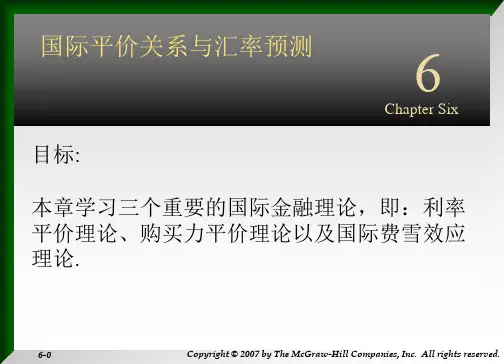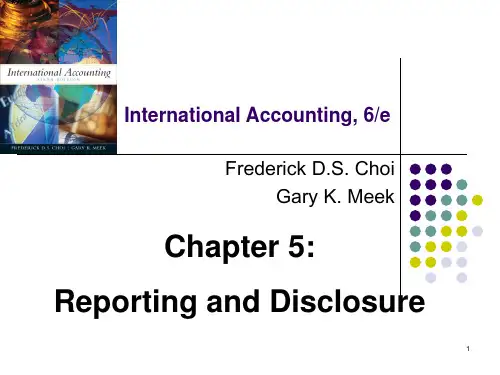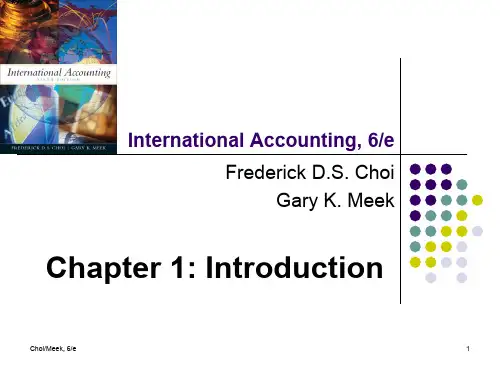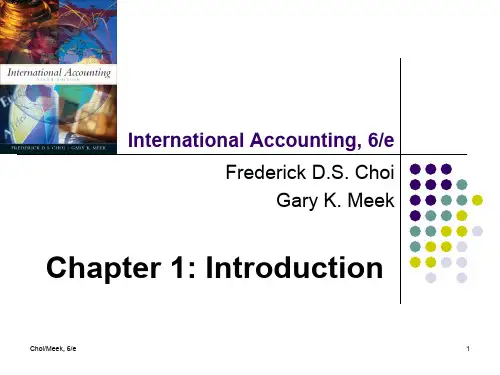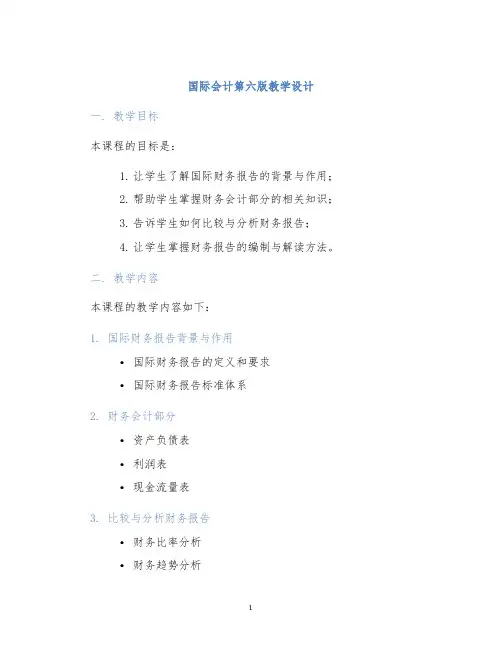- 1、下载文档前请自行甄别文档内容的完整性,平台不提供额外的编辑、内容补充、找答案等附加服务。
- 2、"仅部分预览"的文档,不可在线预览部分如存在完整性等问题,可反馈申请退款(可完整预览的文档不适用该条件!)。
- 3、如文档侵犯您的权益,请联系客服反馈,我们会尽快为您处理(人工客服工作时间:9:00-18:30)。
International Accounting, 6/e Frederick D.S. Choi Gary K. Meek
Chapter 6:
Foreign Currency TranslationBiblioteka Choi/Meek, 6/e
1
Learning Objectives
Why do firms translate from one currency to another?
Facilitates reporting domestic accounts to foreign audiences-of-interest.
Choi/Meek, 6/e
5
Types of Transaction Rates
Spot transactions: the physical exchange of one currency for another in which delivery takes place immediately.
Choi/Meek, 6/e
3
Why do Firms Translate?
Facilitates the preparation of consolidated financial statements that allow readers to see the performance of a multinational company’s total operations both domestic and foreign.
Gain or loss on an unsettled transaction: arises whenever consolidated financial statements are prepared before settlement and the current rate has changed since the transaction date.
Preserves the original cost equivalent of a foreign currency item in the reporting currency.
Use of historical rates do not give rise to
translation gains or losses, which are
Facilitates the measurement of a firm’s exposure to foreign exchange risk.
Choi/Meek, 6/e
4
Facilitates the recording of foreign currency transactions; i.e., foreign currency sales, purchases, borrowing or lending in the consolidated entity’s reporting currency.
Direct quote: the exchange rate specifies the number of domestic currency units needed to acquire a unit of foreign currency.
Indirect quote: the exchange rate specifies
At the transaction date, each asset, liability, revenue, and expense denominated in a foreign currency is measured and recorded in the functional currency of the reporting entity at the spot exchange rate in effect on that date.
What is the difference between a spot, forward, and swap transaction?
What exchange rates are used in the currency translation process and what are their financial statement effects?
At each balance sheet date, recorded balances denominated in a currency other than the functional currency of the reporting entity is adjusted to reflect the current exchange rate.
the price of a unit of the domestic currency in
terms of the foreign currency.
Choi/Meek, 6/e
6
Forward transaction: agreements to exchange a specified amount of one currency for another at a future date.
Choi/Meek, 6/e
9
Accounting for Spot Transactions (contin)
A foreign exchange gain or loss is recorded whenever the exchange rate changes between the original transaction date and the settlement date, or between the original transaction date and the financial statement date should financial statements be prepared prior to settlement.
Spot transaction: occurs when an enterprise purchases or sells goods for which payment is made in a foreign currency, or when it borrows or lends foreign currency.
Choi/Meek, 6/e
2
How does a translation gain or loss differ from a transactions gain or loss?
Is there more than one way of translating financial statements from one currency to another? If so, what are they?
Choi/Meek, 6/e
8
Functional currency is the primary currency in which the reporting entity transacts business and generates and spends cash; e.g., dollars in the case of a U.S. reporting entity.
Choi/Meek, 6/e
10
Example: On September 1, a calendar year U.S. manufacturer sells, on 90-day credit, goods to a Swedish importer for SEK 1,000,000. The dollar/krona exchange rate is $0.14 = SEK1 on September 1, $0.13 = SEK 1 on September 30, and $0.11 = SEK 1 on December 1.
Translation gains or losses: result from a restatement process.
Transactions gains or losses: result from the physical exchange of one currency for another.
Average rate: a simple or weighted average of either historical or current exchange rates.
Choi/Meek, 6/e
14
Translation vs. Transaction Gains or Losses
Choi/Meek, 6/e
15
Gain or loss on a settled transaction: arises whenever the exchange rate used to book the original transaction differs from the exchange rate used at settlement.
Choi/Meek, 6/e
11
Choi/Meek, 6/e
12
Types of Translation Rates and their Statement Effects
Historical rate: the exchange rate prevailing when a foreign currency asset was first acquired or a foreign currency liability first incurred.
Swap transaction: involves the simultaneous spot purchase and forward sale, or spot sale and forward purchase of a currency.



